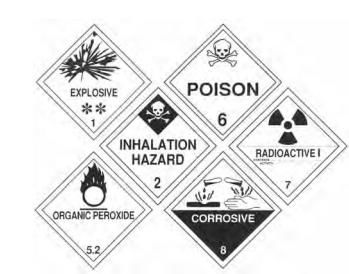Review Questions - Click On The Picture To Begin...

- Poisonous (toxic) gas
- Paranitroaniline
- Small-arms ammunition
- Extremely dangerous poisonous (toxic) liquid
Quote From The CDL Manual:
Buses may carry small-arms ammunition, emergency shipments of drugs, chemicals and hospital supplies. You can carry small amounts of some other hazardous materials if the shipper cannot send them any other way. Buses must never carry:
- Division 2.3 POISONOUS (Toxic) GAS.
- Division 6.1 EXTREMELY DANGEROUS POISONOUS (Toxic) LIQUID.
- Paranitroaniline.
- More than 45 kg (100 pounds) of a solid Division 6.1 Poison.
- More than 225 kg (500 pounds) total of allowable hazardous materials and no more than 45 kg (100 pounds) of any one class.
TruckingTruth's Advice:
Even if you don't plan to obtain a passenger endorsement for your CDL, you will still be required to have a basic understanding of some general rules and regulations for transporting passengers.
- All of these can legally be carried on a commercial bus
- Small-arms ammunition
- Emergency shipments of medical drugs or chemicals
- Hospital supplies
Quote From The CDL Manual:
Buses may carry small-arms ammunition, emergency shipments of drugs, chemicals and hospital supplies. You can carry small amounts of some other hazardous materials if the shipper cannot send them any other way.
TruckingTruth's Advice:
Even if you don't plan to obtain a passenger endorsement for your CDL, you will still be required to have a basic understanding of some general rules and regulations for transporting passengers.
- The temperature
- The current date
- The bus number
- The drivers first name
Quote From The CDL Manual:
When arriving at the destination or intermediate stops, announce:
- The location,
- Reason for stopping,
- Next departure time, and
- Bus number.
TruckingTruth's Advice:
Even if you don't plan to obtain a passenger endorsement for your CDL, you will still be required to have a basic understanding of some general rules and regulations for transporting passengers.
- Baggage can only be placed in the aisle if the owner of the baggage is available to move it when necessary
- No obstacles should ever block an aisle or doorway which may trip other riders.
- Baggage may block doors as long as it is moved when the bus is loading or unloading passengers
- Baggage can only be placed in an aisle if it is tied or secured to a seat
Quote From The CDL Manual:
Do not allow riders to leave carry-on baggage in a doorway or aisle. There should be nothing in the aisle that might trip other riders. Secure baggage and freight in ways that avoid damage and:
- Allow the driver to move freely and easily.
- Allow riders to exit by any window or door in an emergency.
- Protect riders from injury if carryons fall or shift.
TruckingTruth's Advice:
Even if you don't plan on obtaining a CDL passenger endorsement, you will still required to have an understanding of some basic passenger rules and regulations for the written exam.
- A line at the front of the bus that all passengers must stay behind
- A line around each passenger seat to make sure standees don't stand too close to seated passengers
- A bright line on the exit steps to help ensure people don't fall
- A line at the back of the bus, indicating an area where passengers may not stand
Quote From The CDL Manual:
No rider may stand forward of the rear of the driver's seat. Buses designed to allow standing must have a 2-inch line on the floor or some other means of showing riders where they cannot stand. This is called the standee line. All standing riders must stay behind it.
TruckingTruth's Advice:
Even if you don't plan to obtain a passenger endorsement for your CDL, you will still be required to have a basic understanding of some general rules and regulations for transporting passengers.








 TT On Facebook
TT On Facebook